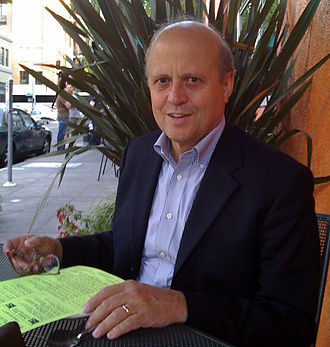
This is the third in the series of “20 Questions with Wally Rhines”
In the early 1970s I was working on a PhD thesis based upon GaAs light emitting diodes, or LEDs. Many of my predecessors in the Materials Science and Engineering Department at Stanford had worked on other aspects of III-V compounds and some of them went to work at HP after completing their PhD’s. The story they told me seems credible so I’ll relate it here.
HP recognized that LEDs would be important for many types of instrumentation. The company pioneered LED research and eventually formed HP Associates to commercialize this business.
In the late 1960s development began on what became the HP-35 calculator. Logic chip contracts were let to both AMI and Mostek and chips developed by both companies ended up in production units of the product. Technology at that time made “reverse Polish” a more logical procedure for entering data and many engineers still prefer the elegance of this approach.
 Choice of a display for the HP-35 logically fell to the most promising technology, GaAsP (Gallium Arsenide Phosphide) which could be tailored to alter the exact wavelength of light emission. GaAs emits light at 1 micron, which is in the infrared and therefore not visible by humans. By alloying GaAs with phosphorus, the “band gap” can be tailored to emit at shorter wave lengths. Armed with this knowledge, the team of relatively young engineers attacked the development task of creating a suitable, reliable red LED for the HP-35 calculator. After analyzing various ratios of arsenic and phosphorus, they selected a combination that emitted a bright cherry red that was easily visible to the entire team of development engineers.
Choice of a display for the HP-35 logically fell to the most promising technology, GaAsP (Gallium Arsenide Phosphide) which could be tailored to alter the exact wavelength of light emission. GaAs emits light at 1 micron, which is in the infrared and therefore not visible by humans. By alloying GaAs with phosphorus, the “band gap” can be tailored to emit at shorter wave lengths. Armed with this knowledge, the team of relatively young engineers attacked the development task of creating a suitable, reliable red LED for the HP-35 calculator. After analyzing various ratios of arsenic and phosphorus, they selected a combination that emitted a bright cherry red that was easily visible to the entire team of development engineers.
Detailed characterization and development of a manufacturing process followed. And then the day came to demonstrate their achievements. A presentation was put together for the Board of Directors of HP. The presentation included the multifaceted issues associated with light emission and culminated with a demonstration of an array of discrete LEDs that were arranged to spell the letters “HP”. When the switch was pulled, Bill Hewlett turned to David Packard and said, “I don’t see anything”. Packard agreed. What the “less than 40” year old engineers had overlooked was the natural narrowing of bandwidth perception that occurs with age. Eye sight, hearing, smell and almost all our senses deteriorate with age. As we become older, the range of frequencies we can perceive decreases. The particular choice of GaAsP alloy that the younger engineers had selected was one that emitted red light in the visible spectrum (above 750nm). But visibility is relative. For 60+ year olds, it wasn’t visible. The entire project went back to the drawing boards to reduce the wavelength of red light emission to a frequency that would be visible to a much broader range of the population.
Red wasn’t the only LED color of interest at the time. The DARPA contract that funded the work I was doing with GaAs, along with Shang-yi Chiang (who later became VP of R&D for TSMC), included Craig Barrett (a faculty advisory who later became CEO of Intel) and Herb Maruska who had worked on Gallium Nitride at RCA before coming to Stanford. Herb had worked with Jacques Pankove at RCA, trying a wide variety of materials for LEDs so that RCA could build solid state televisions. The challenge of short wavelength emitters remained, making the lack of an efficient blue LED a challenge.
Herb tirelessly deposited thin films of GaN with various dopants. And then one day, we systematically analyzed his results. Element by element, I went through the periodic table while Herb told me who had tried various dopants and what the results had been. And then, miraculously, we focused on a group II element, magnesium, that was not well characterized with GaN. Herb headed to the lab and in a short period produced a film of Mg-doped GaN that emitted blue/violet light when a voltage was applied. We were all ecstatic and proceeded to apply for a patent with the help of the Stanford legal staff. The patent was granted later, in 1974, and Herb returned to RCA a hero.
Unfortunately, the blue LEDs were not very efficient. But we published papers and two researchers, Akasaki and Amano, talked to Herb about ten years later and were able to reproduce his results. The history is documented in the article:
A modern perspective on the history of semiconductor nitride blue light sources
Later, the critical missing piece evolved. Shuji Nakamura of UC Santa Barbara fabricated Mg doped InGaN LEDs that operated with a quantum well structure, dramatically improving the efficiency. Nakamura’s advance was remarkable and he clearly deserved the Nobel Prize that he received (along with Akasaki and Amano who were able to reproduce both Nakamura’s and our results, as well as achieve stimulated emission). Nakamura highlighted the Stanford work when the Nobel Prize was announced, saying he believed recognition for the blue LED should also extend to Herbert Paul Maruska, a researcher at RCA who created a functional blue LED prototype in 1972. Nakamura said he did not think his or Akasaki and Amano’s work would have been possible without Maruska’s contributions many years prior.
Nakamura Gives Some Credit to Maruska for Blue LED Invention
20 Questions with Wally Rhines Series
Share this post via:







Quantum Computing Technologies and Challenges